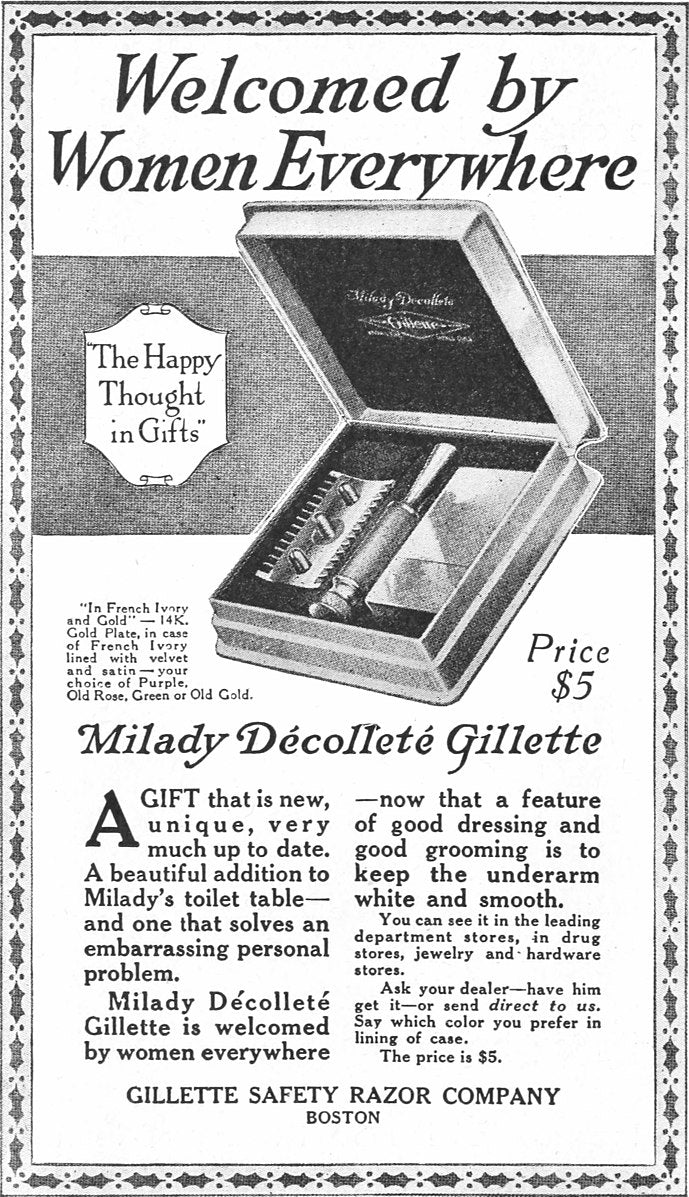Women's shaving has a long and varied history that spans many cultures and time periods. While it is often assumed that women have always shaved their legs and underarms, the reality is that the practice has gone in and out of fashion over the centuries, and has been subject to various social and cultural pressures.
The earliest evidence of women shaving comes from ancient Egypt, where both men and women shaved their entire bodies for hygienic and aesthetic reasons. Women used a variety of tools for hair removal, including bronze razors, pumice stones, and depilatory creams made from ingredients like resin and beeswax.
In ancient Greece and Rome, hair removal was also a common practice, but it was primarily done by prostitutes and courtesans, who shaved to distinguish themselves from respectable women who were expected to remain unshaven. Roman women, in particular, were known for their elaborate hairstyles and often used depilatory creams made from a mixture of quicklime and arsenic to remove unwanted hair from their faces and bodies.
During the Middle Ages, women's hair removal was largely ignored, as some entities regarded excessive concern with one's appearance as a form of vanity and sin. However, in the Renaissance period, women once again began to shave their faces and bodies, as the ideal of beauty shifted towards a more youthful and delicate appearance.
In the 18th and 19th centuries, women's shaving became more common, but it was primarily limited to the upper classes. The trend for women to wear more revealing clothing, such as short sleeves and shorter hemlines, led to a greater emphasis on smooth, hairless skin. However, it was still seen as somewhat scandalous and was often done in secret.
It wasn't until the early 20th century that women's shaving became more widespread and socially acceptable. The rise of mass-produced safety razors and the advent of advertising campaigns aimed at women helped to popularize the practice. In 1915, Gillette launched a campaign targeted at women called "The First Great Anti-Hair Movement," which emphasized the importance of smooth, hairless skin for feminine hygiene and beauty.
During the 1920s and 1930s, women's shaving became even more popular, as hemlines continued to rise and sleeveless dresses became fashionable. Advertisements for razors and depilatory creams featured images of beautiful, smooth-skinned women, further reinforcing the idea that hairlessness was a necessary component of feminine beauty.
In the post-World War II era, women's shaving became even more widespread, as the bikini and other revealing styles of clothing became popular. The 1960s saw the rise of the feminist movement, which challenged traditional gender roles and encouraged women to question the beauty standards that had been imposed upon them. Some feminists saw hair removal as a symbol of patriarchal oppression, while others embraced it as a personal choice.
Today, women's shaving is an established part of the beauty industry, with a wide variety of products and services available to help women achieve smooth, hairless skin. While some women choose not to shave or to only shave certain parts of their bodies, for many, it remains an essential part of their grooming routine. As attitudes towards beauty and femininity continue to evolve, it will be interesting to see how the practice of women's shaving continues to change and adapt.


2 comments
Thanks for this. Really helpful read 😊
Women’s grooming and grooming products have had a fascinating and sometimes frightening history. I think many women today, including me, are intelligent enough to be able to spot most marketing gimmicks for what they are, but it takes some time to find “artisan” products, or “natural” products that are what they say they are, and work like they claim to work. For the right balance of quality, performance, and other factors (for me, Made in the USA is a top feature I look for) we will get out our wallets. Some women associate shaving with being expected to appear a certain way by a patriarchal society; for me, it is mainly about hygiene and tactile sensation. I dislike the feeling of my unshaven legs after a certain point; I can’t even contemplate not shaving my underarms, like, ever. But as a bit of a feminist, I also desire shaving products made for ME that equal or exceed the quality of men’s products. I must admit my experience is more limited than some; until very recently, I was an outdoorswoman by trade and desire, and had small use for more expensive grooming products. My journey to wet shaving began several months back, when I was attempting to minimize or eliminate most plastics, a room at a time. So I began looking at my bathroom first. I found the easiest thing to do first was to find bar soap and get away from plastic shampoo and soap containers. That led me to my razor and cream, and the rest is organic. My first look at a modern stainless steel safety razor online and I was hooked, remembering that my parents and grandparents had used these things for decades. But then I went looking for artisan shave products specifically for women. I found more than I might have anticipated, but not a lot. One company I just found, Stirling, makes an entire fairly robust line of artisan shave soaps and after shaves, an even tougher find, for women. (By the way TRC—you don’t seem to be featuring those women’s soaps on your website, unless I missed something. All your Stirling products are either unisex type scents like citron or mint or very definitely geared for men. Hint hint—carry some of the women’s scents, like Duchess and Evie, which I just picked up. Both are lovely.)
It’s nice to see that things are changing for the better, with more products out there designed for women. I’m glad to see this and I hope the DE shaving world continues to step up and provide products for women. We have shaving needs that are a little different from men’s. One, we need a bigger brush. We have a lot more surface area to lather. I think a 26mm is a good starting point. Those bigger brushes require bigger bowls to lather in. We need lather bowls that are designed for bigger brushes and will hold more volume, but are also a)unbreakable —we have to shave in the shower sometimes and it’s not a place for a fragile marble or ceramic bowl, but b) attractive and c)easy to grip and hold for smaller hands. Bowls that can hang are a plus. A brush that had a built in hanging device or magnets in the handle to allow it to stick upside down to dry properly for travelers or just busy people with limited space for setting up brush stands. I hope someone out there is taking notes! Thanks for the informative historical post about women’s shaving. I hope we keep on seeing more creativity and ground-breaking products in this niche.